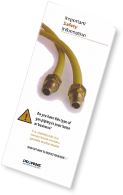Winter Tips
Keep your
driveway clear
of snow and ice
Keep
equipment clear
of snow and ice
Keep gas appliance
vents clear of
snow and ice
Mark location of
underground
tanks
To ensure safe access to your propane tank, please keep snow and ice cleared from your driveway and sand all inclines. A propane delivery truck is approximately two feet wider than a passenger car and much taller, so please keep trees/bushes that line your driveway trimmed, including low-hanging branches. If our delivery person is unable to navigate your driveway without obstruction, we will not be able to fill your tank, which could result in a special delivery/trip charge and/or you running out of gas.
To prevent a gas leak, please keep your propane tank, equipment and piping clear of snow and ice accumulation. The weight of these elements could eventually break gas connections.
To avoid gas fumes from becoming trapped in your home, please make sure that your chimney and roof top, as well as all gas appliances vented through the roof or walls remain clear of snow and ice. Should snow or ice cover a vent, the appliance may stop operating.
Please mark the location of your underground tank and provide a clear pathway. This will aid our efforts to keep you supplied with gas all winter.
Corrugated
Stainless Steel
Tubing (CSST)
Lightning Safety Warning from Manufacturers of Corrugated Stainless Steel Tubing (CSST)
Corrugated Stainless Steel Tubing (“CSST”) is flexible, stainless steel piping that is used in residential, commercial and industrial settings for the transmission of liquefied petroleum gas (“LPG”), more commonly known as propane. CSST is distinguishable by its yellow (or black) exterior plastic coating. As installed inside a home or business, CSST is typically located within the walls of a structure, through or alongside floor joists in a basement, or on top of ceiling joists in an attic.
Lightning strikes at or near properties equipped with CSST have occasionally been reported to result in fires at those properties. It is believed that nearby lightning strikes can cause electrically conductive components, like CSST, to become energized, which can result in pitting or other damage to the CSST and, in turn, could cause an explosion and/or fire. If you determine that you have CSST at your home or business, CSST manufacturers strongly encourage you to make sure your CSST system is properly bonded and grounded in order to reduce the risk of damage from a lightning strike. The manufacturers recommend contacting a licensed electrician to perform such bonding and grounding work.
States with significant lightning risk include, but are not limited to: Alabama, Arkansas, Florida, Georgia, Illinois, Indiana, Iowa, Kentucky, Louisiana, Maryland, Michigan, Mississippi, Missouri, New Mexico, North Carolina, Ohio, Oklahoma, Pennsylvania, South Carolina, Tennessee, Texas, Virginia and West Virginia, as based on data collected by the National Lightning Detection Network and compiled in the Cloud-to-Ground Flashes by State 1997 to 2012: www.lightningsafety.noaa.gov/stats/97-12Flash_DensitybyState.pdf
For more information on CSST safety, please visit www.csstsafety.com
For more information about the various CSST products manufactured by CSST manufacturers, please visit their individual websites, a non-exclusive list of which is below. These website links are provided for convenience; AmeriGas assumes no responsibility or liability for the content contained on any of the following websites:
- Metal-Fab, Inc. (manufacturer of Diamondback) - www.mtlfab.com
- Omegaflex, Inc. (manufacturer of TracPipe and CounterStrike) - www.tracpipe.com
- Parker Hannifin, Corp. (manufacturer of
Parflex) – www.parker.com - Pro-Flex, LLC (manufacturer of ProFlex CSST Flexible Gas Piping) - www.proflexcsst.com
- Titeflex Corporation (manufacturer of the Gastite System Corrugated Stainless Steel Tubing) - www.gastite.com/index.html
- Ward Manufacturing, Inc. (manufacturer of Wardflex and Wardflex II) - www.wardflex.com/index.htm


